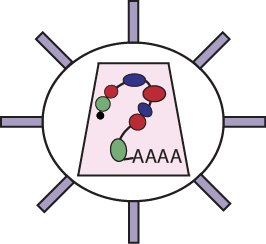RNA viruses represent a major health threat to humans and other living organisms. In particular, human immunodeficiency virus (HIV), causative agent of acquired immunodeficiency syndrome, is the second cause of death worldwide due to a single pathogen and has reached a pandemic scale with 37 million people currently infected. The high mutation rate of viral RNA genomes usually lead to rapid evolution and resistant virus strains, making difficult the development of effective antiviral treatments, vaccines and a final cure. Understanding how viruses interact with the host cell remain essential for the eventual discovery of complementary therapeutic strategies.
RNA has a central role in virus biology, yet viral genomes typically encode only a few proteins able to interact with RNA. Hence, viruses exploit host RNA-binding proteins (RBPs) to accomplish their biological cycle. RBPs are also at the frontline of cellular antiviral responses.
RBPs control RNA fate from synthesis to decay. RBPs participate in virtually every step of infection and are one of the main players mediating virus-host interactions.
Although poorly explored until now, many of these RBPs are promising targets for host-based antiviral intervention that can be more refractory to the emergence of drug resistance.
